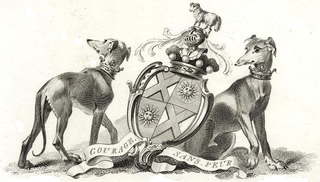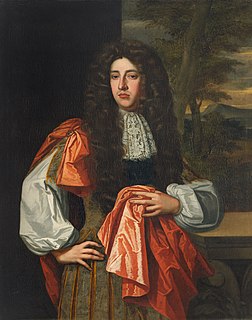Related Research Articles

Earl of Lichfield is a title that has been created three times, twice in the Peerage of England and once in the Peerage of the United Kingdom (1831). The third creation is extant and is held by a member of the Anson family.

Marquess Townshend is a title in the Peerage of Great Britain held by the Townshend family of Raynham Hall in Norfolk. The title was created in 1787 for George Townshend, 4th Viscount Townshend.

Earl of Perth is a title in the Peerage of Scotland. It was created in 1605 for James Drummond, 4th Lord Drummond. The Drummond family claim descent from Maurice, son of George, a younger son of King Andrew I of Hungary. Maurice arrived in Scotland on the ship which brought Edgar Ætheling, the Saxon claimant to the crown of England after the Norman Conquest, and his sister Margaret to Scotland in 1068. Maurice was given lands in Lennox (Dunbartonshire), together with the hereditary stewardship of the county. The Hungarian Prince theory has been discounted as no evidence of any relationships exists in written records or DNA. "The Red Book of the Menteiths" clearly discounts the Hungarian Prince as a myth likely formed to give status to the Drummond origins. The Drummonds in the 12th Century were allied to the Menteiths – their early fortunes developed through the relationship. Indeed, one "Johannes De Drumon", said to have died in 1301, was buried in Inchmahome Priory which was founded by the Menteiths. His successor John Drummond, the 7th Steward, was deprived of the lands and retired into Perthshire.

Earl of Macclesfield is a title that has been created twice. The first creation came in the Peerage of England in 1679 in favour of the soldier and politician Charles Gerard, 1st Baron Gerard. He had already been created Baron Gerard, of Brandon in the County of Suffolk, in 1645, and was made Viscount Brandon, of Brandon in the County of Suffolk, at the same time as he was given the earldom. These titles are also in the Peerage of England. Lord Macclesfield was the great-grandson of the distinguished judge Sir Gilbert Gerard, Master of the Rolls from 1581 to 1594. He was succeeded by his eldest son, the second Earl. He was involved in the Rye House Plot of 1683, was sentenced to death but later pardoned by the King. On his death without legitimate issue in 1701 the titles passed to his younger brother, the third Earl. He had earlier represented Yarmouth, Lancaster and Lancashire in the House of Commons. When he died in 1702 the titles became extinct.

Viscount Bolingbroke is a current title in the Peerage of Great Britain created in 1712 for Henry St John. He was simultaneously made Baron St John, of Lydiard Tregoze in the County of Wilts. Since 1751 the titles are merged with the titles of Viscount St John and Baron St John in the same peerage.

Viscount Falmouth is a title that has been created twice, first in the Peerage of England, and then in the Peerage of Great Britain. The first creation came in the Peerage of England in 1674 for George FitzRoy, illegitimate son of King Charles II by Barbara Villiers. He was created Earl of Northumberland at the same time and in 1683 he was made Duke of Northumberland. However, he left no heirs, so the titles became extinct at his death in 1716.

Earl of Onslow, of Onslow in the County of Shropshire and of Clandon Park in the County of Surrey is a title in the Peerage of the United Kingdom. It was created in 1801 for George Onslow, 4th Baron Onslow. The Onslow family descends from Arthur Onslow, who represented Bramber, Sussex and Guildford in the House of Commons. He was the husband of Mary, daughter of Thomas Foote, Lord Mayor of London in 1649, who had been created a Baronet in 1660. In 1674 Onslow was himself created a Baronet in the Baronetage of England, with the precedence of 1660.

Earl of Rosse is a title that has been created twice in the Peerage of Ireland, both times for the Parsons family.
Viscount Molesworth, of Swords in the County of Dublin, is a title in the Peerage of Ireland. It was created in 1716 for Robert Molesworth. He was made Lord Molesworth, Baron of Philipstown, of King's County, at the same time, also in the Peerage of Ireland. Molesworth had been invested as member of the Irish Privy Council in 1697, represented Camelford, Lostwithiel, East Retford and Mitchell in the British House of Commons and served as British Ambassador to Denmark. His elder son, the second Viscount, notably served as Ambassador to the Kingdom of Sardinia, the Grand Duchy of Tuscany and the Republic of Venice. He was succeeded by his younger brother, the third Viscount. He was a Field Marshal in the Army. On the death of his son, the fourth Viscount, this line of the family failed, and the titles passed to the latter's first cousin, the fifth Viscount. He was the eldest son of the Hon. William Molesworth, third son of the first Viscount. His son, the sixth Viscount, was a Major-General in the Army, who was lost in the wreck of Arniston. On his death this line of the family also failed and the titles were inherited by his second cousin, the seventh Viscount. He was the eldest son of Richard, third son of the Hon. William Molesworth, third son of the first Viscount. He was succeeded by his nephew, the eighth Viscount. As of 2010, the titles are held by the latter's great-grandson, the twelfth Viscount, who succeeded his father in 1997.

Viscount Gage, of Castle Island in the County of Kerry of the Kingdom of Ireland, is a title in the Peerage of Ireland. It was created in 1720 for Thomas Gage, along with the subsidiary title of Baron Gage, of Castlebar in the County of Mayo, also in the Peerage of Ireland. In 1744 he also succeeded his cousin as eighth Baronet, of Firle Place. The titles remain united. The Gage family descends from John Gage, who was created a baronet, of Firle Place in the County of Sussex, in the Baronetage of England on 26 March 1622. His great-grandson, the seventh Baronet, represented Seaford in Parliament. He was succeeded by his first cousin, Thomas Gage, 1st Viscount Gage, the eighth Baronet. He sat as a Member of Parliament for Minehead and Tewkesbury and also served as Governor of Barbados. In 1720, 24 years before succeeding in the baronetcy, he was raised to the Peerage of Ireland as Baron Gage and Viscount Gage. His second son was the military commander the Hon. Thomas Gage.
Viscount Hampden is a title that has been created twice, once in the Peerage of Great Britain and once in the Peerage of the United Kingdom. The first creation came in the Peerage of Great Britain when the diplomat and politician Robert Hampden, 4th Baron Trevor, was created Viscount Hampden, of Great and Little Hampden in the County of Bedford on 14 June 1776. The title of Baron Trevor, of Bromham, had been created in the Peerage of Great Britain in 1712 for his father, the lawyer Sir Thomas Trevor. Both titles became extinct in 1824 on the death of the first Viscount's second son, the third Viscount.

Viscount Selby, of the City of Carlisle, is a title in the Peerage of the United Kingdom. It was created in 1905 for the Liberal politician Sir William Court Gully upon his retirement as Speaker of the House of Commons. He was the son of the physician James Manby Gully. The title of the viscountcy derived from the maiden name of Gully's wife, Elizabeth Selby, daughter of Thomas Selby. As of 2017 the title is held by the first Viscount's great-great-great-grandson, the sixth Viscount, who succeeded his father in 2001.

Viscount Sackville, of Drayton in the County of Northampton, was a title in the Peerage of Great Britain. It was created in 1782 for the soldier and politician Lord George Germain. He was made Baron Bolebrooke, in the County of Sussex, at the same time, also in the Peerage of Great Britain. Born Lord George Sackville, he was the third son of Lionel Sackville, 1st Duke of Dorset. He was succeeded by his son, the second Viscount. In 1815 he succeeded his cousin as fifth Duke of Dorset. All his titles became extinct on his death in 1843.

The title Earl Castleton, of Sandbeck in the County of York, was created in the Peerage of Great Britain in 1720 for the 6th Viscount Castleton, who had previously been created Baron Saunderson, of Saxby in the County of Lincoln, in 1714, and Viscount Castleton, of Sandbeck in the County of York, in 1716, both also in the Peerage of Great Britain.

Earl Fitzwilliam was a title in both the Peerage of Ireland and the Peerage of Great Britain held by the head of the Fitzwilliam family.
Viscount of Kenmure was a title in the Peerage of Scotland. It was created by Charles I in 1633 for the prominent Presbyterian Sir John Gordon, 2nd Baronet. He was made Lord Lochinvar at the same time, also in the Peerage of Scotland. Both titles were created with remainder to "heirs male whatsoever bearing the arms and name of Gordon"
The Queen's Remembrancer is an ancient judicial post in the legal system of England and Wales. Since the Lord Chancellor no longer sits as a judge, the Remembrancer is the oldest judicial position in continual existence. The post was created in 1154 by King Henry II as the chief official in the Exchequer Court, whose purpose was "to put the Lord Treasurer and the Barons of Court in remembrance of such things as were to be called upon and dealt with for the benefit of the Crown", a primary duty being to keep records of the taxes, paid and unpaid.
Viscount Saye and Sele was a title in the Peerage of England. It was created on 7 July 1624 for William Fiennes, 8th Baron Saye and Sele and became extinct on the death of Richard Fiennes 6th Viscount on 29 July 1781.

Thomas Fanshawe, 1st Viscount Fanshawe KB was an English politician who sat in the House of Commons at various times between 1621 and 1661. He supported the Royalist cause in the English Civil War. Following the Restoration he was raised to the peerage.

Charles Fanshawe, 4th Viscount Fanshawe (1643-1710) was an Irish Peer and Member of the House of Commons. He was the third surviving son of Thomas Fanshawe, 1st Viscount Fanshawe and his second wife, Elizabeth Cockayne.